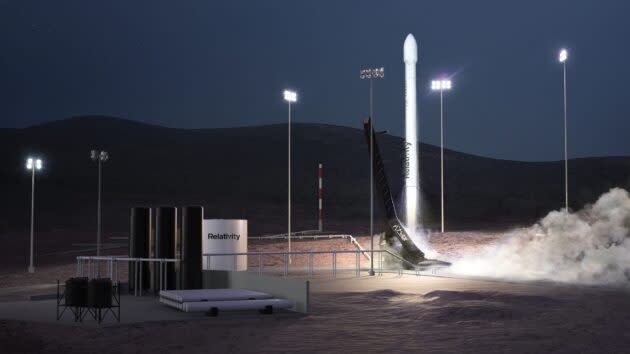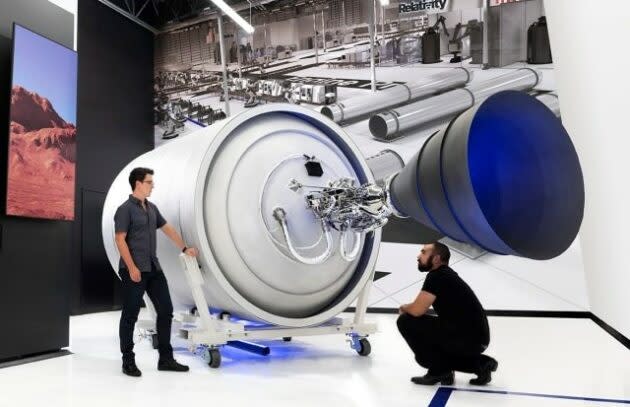Relativity makes deals with Vandenberg AFB and Iridium for California launches

Relativity Space, a startup that was born in Seattle but grew up in Los Angeles, says it has signed an agreement to develop launch facilities at Vandenberg Air Force Base in California, and a contract with Iridium to launch satellites from those facilities.
The flurry of announcements marks a significant expansion for a company that barely existed five years ago but has raised $185 million since then.
Relativity is gearing up to build rocket parts using giant 3-D printers in Southern California, testing rocket engines at NASA’s Stennis Space Center in Mississippi and creating a launch complex at Cape Canaveral Air Force Station in Florida. The first launch of its Terran 1 rocket is scheduled for late next year at the Cape.
Florida is well-suited for launches into low- and mid-inclination orbits — the kinds of orbits that have been traced by space shuttles and the International Space Station. But Vandenberg is tailor-made for the pole-to-pole orbits used for the satellites in Iridium’s telecommunications constellation.
The newly announced right-of-entry agreement with the Air Force clears Relativity Space to assess its options for conducting launch operations from Vandenberg’s Building 330 and adjacent areas. If the project proceeds as planned, Relativity would be ready to start launching satellites into polar and sun-synchronous orbits from its California launch pad in 2023.
“Expanding to two launch sites is a huge step for us as a company, continuing our momentum and growth,” Jordan Noone, Relativity’s co-founder and chief technology officer, told GeekWire.
Col. Anthony Mastalir, commander of Vandenberg’s 30th Space Wing, said in a news release that his unit “takes great pride in supporting the next generation of leaders in space.”
“We are impressed by Relativity’s innovative approach to reinventing aerospace manufacturing via 3-D metal printing and robotics, paired with an executive team of seasoned aerospace leaders,” Mastalir said.
The schedule for setting up the Vandenberg launch site meshes with the timetable for Relativity’s Iridium contract — which calls for up to six dedicated launches starting no earlier than 2023.
The second-generation Iridium NEXT constellation was delivered to low Earth orbit by eight SpaceX Falcon 9 rocket launches over the course of two years. Each launch sent up a batch of as many as 10 satellites.
Iridium’s current constellation consists of 66 operational satellites and nine on-orbit spares. Six spare satellites remain in ground storage, and those are the spacecraft that Relativity would launch on an as-needed basis.
“The upgraded Iridium satellite constellation is operating incredibly well, but it’s prudent to have a cost-effective launch option available for future spare delivery,” Iridium CEO Matt Desch said in a news release. “Relativity’s Terran 1 fits our launch needs to LEO well from both a price, responsiveness and capability perspective.”
Financial terms of the agreement weren’t disclosed.
Noone said the Terran 1’s ability to send up to 2,000 pounds of payload into a pole-to-pole orbit was a good match for Iridium’s 1,500-pound satellites.
That particular payload capacity is a relatively open market niche in the launch industry. Rocket Lab, Virgin Orbit and Astra are targeting the lower end of the spectrum, while the bigger players — including Arianespace, Blue Origin, Northrop Grumman, SpaceX and United Launch Alliance — are going after the higher end.
Noone said Relativity Space and Firefly Aerospace, another startup that hasn’t yet gotten off the ground, were shaping up as the U.S.-based launch providers of choice for 2,000-pound (1,000-kilogram) payloads.
“The last rocket to be flying consistently at that size was the Delta 2,” he said.

Noone and Relativity’s other founder, Tim Ellis, have rocketry roots that connect up with Blue Origin, Amazon CEO Jeff Bezos’ space venture. Before Relativity, Ellis worked on propulsion development and 3-D printing at Blue Origin. Noone was a Blue Origin intern, then went on to work at SpaceX as a propulsion engineer, and then joined up with Ellis in 2015 to get Relativity started in Seattle.
“We had our first office in the WeWork [co-working space] in South Lake Union,” Noone recalled. “The world is a very different place from what it was five years ago — for us, the world in general and for WeWork.”
Relativity relocated to the Los Angeles area by the time it came out of stealth. Thanks to 3-D printing technology, the company’s Terran 1 rocket is designed to be built in less than 60 days, with a target launch cost of $10 million. Future customers include Seattle-based Spaceflight Inc., the Canadian satellite operator Telesat and space startups Momentus and mu Space.
The company’s rapid growth has been fueled by high-profile investments from Bond, Tribe Capital, Playground Global, Y Combinator, Social Capital and billionaire tech entrepreneur Mark Cuban. One of the more recent investors is former Zillow CEO Spencer Rascoff.
The funding has allowed Relativity to assemble a team of about 165 employees who include some high-profile hires, such as Zachary Dunn, SpaceX’s former senior vice president of propulsion and launch.
In addition to the deals with the Air Force and Iridium, Relativity announced today that Muhammad Shahzad has joined the company as its chief financial officer. Shahzad, who most recently served as CFO for The Honest Company, brings more than 15 years of experience in finance and capital markets to Relativity.
“We’ve always had a really strong ability to hire top talent from other companies,” Noone said, “and that’s preparing the company for the next phase of growth.”
